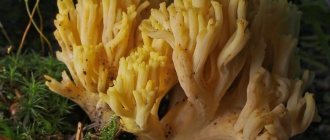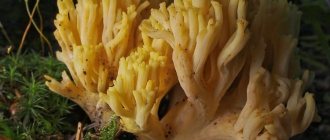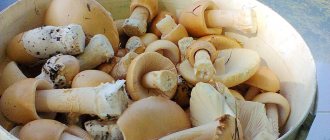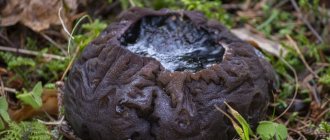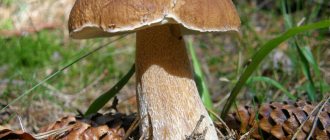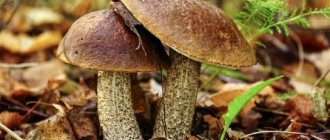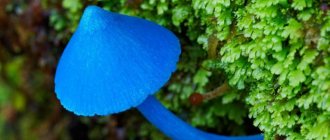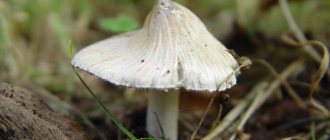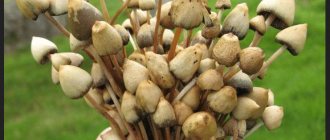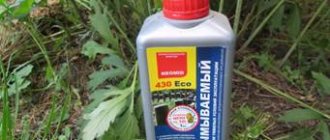Mushrooms
0
2268
Article rating
Kira Stoletova
The mushroom kingdom is distinguished by a great diversity of representatives. They have different properties and appearance, sometimes very bizarre. These include the horned mushroom, which, due to its unusual appearance, is popularly called “deer horns.”
Features of the horned mushroom
Is the horned mushroom edible or not? Rogatiki mushrooms
Rogatik is the common name for basidal fungi.
General description The fruiting bodies are erect, rod-shaped, club-shaped or branched in the form of a bush. The color is white, gray, yellow, cream and other colors. Inhabits forests on soil, litter and rotten wood. Many are edible, but are not usually collected by the public. There are no poisonous ones that are dangerous to human life. But there are inedible ones, with a bitter taste or unpleasant odor.
Rogatiki:
Conditionally edible
Ramaria yellow
Lat:
Ramaria flava
Synonyms: Yellow stag, Bear paw, Deer horns, Yellow coral.
74249
10
Clavicorona flap-shaped
Lat:
Artomyces pyxidatus
Synonyms: Artomyces vitreous, Clavicorona box-shaped, Deer horns, Mushroom cabbage, Mushroom noodles, Clavicorona pyxidata.
15252
15
10412
5
Ramaria vulgare
Lat:
Ramaria eumorpha
Synonyms: Invala hornet, Spruce hornet, Ramaria Invalii, Clavaria invalii, Clavariella eumorpha.
Light ocher, yellowish bushes of Ramaria Intvala are often found in coniferous forests; this is one of the most common types of ramaria.
Characteristics:
- Shape: coral-shaped
7016
2
Clavulina coralliformes
Lat:
Clavulina coralloides
Synonyms: Clavulina cristata, Clavulina cristata.
Headings: K, Inedible mushrooms
6778
3
In coniferous or mixed forests, height 7-12 and thickness 1-3 centimeters
Characteristics:
- Shape: club-shaped
6225
2
Narrow, tall: up to 10-15 cm tall, up to 1 cm thick at the widest part. In deciduous and mixed, you need oak, aspen, birch.
Similar species [edit | edit code]
The genus Plutea has more than 140 species, some of which are difficult to distinguish from each other.
- Black-margined pluteus, Pluteus atromarginatus (Singer) Kühn. , is a rarer species, which is distinguished by a blackish cap and darkly colored edges of the plates. Grows on half-rotten coniferous trees.
- Pluteus pouzarianus Singer is distinguished by the presence of buckles on the hyphae, which are only visible under a microscope. It grows on soft trees and has no distinct odor.
- Similar representatives of the related genus Volvariella
are distinguished by the presence of a volva. - Similar representatives of the genus Entoloma
have attached plates instead of free ones. They grow on the soil. - Broad-plated collibia, Megacollybia platyphylla (Pers.) Kotl. & Pouzar, an inedible or conditionally edible mushroom, is distinguished by sparse, whitish or cream-colored plates and characteristic strands at the base of the stalk.
Ramaria mushroom. Yellow Ramaria (Ramaria flava)
A mushroom of an exotic species, nevertheless often found in forests, especially in the Leningrad region, rep. Karelia, Caucasus, Far East and Eastern Siberia. People also call it yellow hornet, coral mushroom, yellow coral. Gardeners can find the mycelium of this mushroom on sale for self-cultivation under the name Mushroom Noodles (from Chinese). Mushroom coral can be found from July until October, mainly in coniferous forests. It prefers moist, shaded places, but often grows abundantly in well-lit meadows. It can grow singly, in small groups and in large formations in the form of semi-rings.
The bushy yellow hornet actually looks like part of a coral. It can reach 25-30 cm in height with a total weight of 2-3 kg. Numerous, successively bifurcating branches extend from the thick base (which can be called the stalk). They are of equal length (comparatively long), highly branched, bush-like, fleshy, cylindrical or flattened, smooth, with blunt, irregularly truncated or jagged (often double) ends. At a young age, the branches are yellow, at a more mature age they can be painted in any shades of yellow: yellowish, apricot-, lemon-, sulfur-, dirty pale and gray-yellow, golden ocher or creamy, at maturity - ocher or orange . Closer to the so-called stem, the fruiting body is sulfur-yellow. The base itself is thick, 2 to 8 cm high, 4 to 5 cm in diameter, tapering downward. It is dense, whitish or yellowish in color (usually the same color with branches). It may be covered with reddish spots of varying sizes or darkens when pressed (to a reddish or wine-brown color). The pulp is white, off-white or yellowish, in the stem it looks like marble, at the break the color does not change or becomes reddish-brown. Watery, with a pleasant, slightly herbaceous odor, in youth fragile, soft, with a pleasant or insipid taste, with age it begins to taste bitter (especially the tops) and becomes rubbery.
Can be confused with other types of ramaria:
- golden (has a whitish base and shorter branches);
- with the weakly poisonous, beautiful tricolor ramaria (has yellow- and ocher-brownish branches (the main ones with a pinkish tint), with a bright pink stem in youth and whitish in maturity, with slightly bitter flesh);
The mushroom is edible. Young sprigs of horned grass are especially tasty in mushroom soups. You can salt it (pre-boil for 10 minutes before salting). In adults, the upper part of the branches may taste bitter, so they are usually removed.
Description
Rogatiki are mushrooms that are very different in appearance from other representatives of this kingdom. They do not have a clearly defined stem and cap, the fruit body is homogeneous - club-shaped or awl-shaped. Some varieties have a branched structure, similar to corals.
Rogatik pistil is an elongated mushroom, its height can be 15-30 cm. It is large, light yellow in color, and cylindrical in shape. Narrow at the bottom, widening at the top, shaped like a mace or pestle. The apex is smoothed, semicircular. The width reaches 5 cm.
The pulp is like a sponge, easily compressed, porous, and denser in young fruits. The spores are white or slightly yellowish and are located on the surface. The skin is smooth, light, pleasant to the touch. The flesh turns red when touched and quickly darkens when cut. With age, grooves form on the fruiting body. The pulp becomes bright yellow, dark or orange in older fruits.
Rogatik comb. Horntails
Rogatik comb
The most common species of the genus Clavulina. It grows most abundantly in coniferous forests, but is also found in deciduous forests, as well as in the grass of meadows and pastures. Distributed throughout the temperate zone of the northern hemisphere. This saprotrophic mushroom with characteristic points at the ends of its branches has many variations in color and shape. Inedible due to bitter taste. Related species, such as the gray or smoky purple-fruited C. cinerea and the purple-colored C. amethystina, have blunt branchlets. Both of these species are edible. The genus Clavulinopsis is very similar to the genus Clavulina, but is richer in species. In Europe alone there are almost thirty of them. Cornflower (Clavulinopsis corniculata) grows abundantly throughout the temperate zone of the northern hemisphere in meadows, pastures, grassy roads, etc. Due to its bitter taste, it is inedible. A characteristic feature of this fungus—the serrated ends of the branches—is absent in related species. C. umbrinella is white, later becoming pale brown and brown. The cream or yellowish fruiting bodies of C. luteo-ochracea have almost no branches. Clavulinopsis corniculata grows in clumps or singly. The fruiting bodies are 3-8 cm high, divided two or three times into finger-shaped elongated branches (6), which become slimy in wet weather. Color from yellow to ocher-yellow. The pulp is orangeish (7), the taste is tart or bitter, it smells like flour. Spore powder is white. Spores (8) are colorless, with one large fatty droplet, 4-6 cm. Basidia with four sterigmata. Clavulina cristata has fruiting bodies growing in bunches and separately, 3-8 cm in height. The fragile branches, divided at the ends, are flattened and bear combs with points. Color whitish, white, pinkish. The pulp is white, the taste is moderate, then bitter. The smell is inexpressive. Spore powder is white. Spores (3) are colorless with a large fatty droplet 8-10 cm long. Basidia have two sterigmata.
Nutritional value
Snow mushrooms are very nutritious. They contain dietary fiber (70%), proteins, carbohydrates, vitamin D, 18 valuable amino acids, three quarters of which are essential for the human body, beneficial minerals and plant glycogens (trehalose, mannitol and pentosan).
For comparison, there is more multivitamin D in coral mushrooms than in cod liver, salmon, tuna, shrimp and sunflowers combined.
Composition and calorie content of tuna.
They contain a lot of calcium, phosphorus, potassium, iron, magnesium, sodium and sulfur. At the same time, there is really a lot of calcium and iron: 643 mg of calcium and 30.4 mg of iron per 100 g of product.
Ramaria vulgare. How to distinguish straight slingshots
Straight cornea can be confused with Calocera viscosa. Upon closer examination, significant differences can be found between the species. The color of calocera adhesive is more saturated, almost flashy. The fruit body may be bright yellow or bright orange. The height of the calocera does not exceed 10 cm. Numerous branches branch dichotomously, that is, the main axis bifurcates and stops its own growth. This branching is repeated many times, as a result of which the mushroom becomes like a bush, coral or a frozen fire. Classified as inedible.
Common ramaria (Ramaria eumorpha) is the closest relative of the straight hornet. The species are very similar in appearance. The fungus is widespread throughout the Russian Federation, where there are coniferous forests. Fruits from late July to early October. It grows in groups on spruce or pine litter, often forming so-called “witch circles.”
The vertical branches of common ramaria are distinguished by sharper tips compared to straight ramaria. The fruiting body is represented by a dense bush 1.5-9 cm high and up to 6 cm in diameter. The mushroom is uniformly colored in a light ocher or ocher-brown color; there are numerous thorns and warts on the surface of the branches.
Comment! It is considered a conditionally edible product with low taste. It is eaten after prolonged soaking followed by boiling.
Artomyces pyxidatus can also be mistaken for a straight horned plant. The species has vertical coral-like branches. The fruiting body is painted in a calm ocher-yellowish color. The clavicorona can be distinguished from the straight horntail by its size: sometimes it grows up to 20 cm in height. Another difference is the characteristic crown-shaped tips, which from a distance resemble the crenellated towers of a medieval castle. The habitats of the species are also different. Unlike the straight horned clam, the clavicorona clavicorona loves to grow on rotting deciduous wood, especially on old aspen logs.
Characteristic features of the variety
The botanical name of the coral is Ramaria yellow, which belongs to the family Rogataceae. The shape of the cattail resembles the branched antlers of a deer or underwater coral.
Description of deer horns and photo of the mushroom
The photo clearly shows that the ground part of the deer horn mushroom is very branched.
Its color depends on several factors:
- habitats;
- climate features;
- age.
The branches can be beige, light brown, light yellow, orange or purple. Basically, the height of the fruiting body does not exceed 7 cm, but the width varies from 15 to 30 cm. When pressing on the fruit, a light brown tint appears. When cut, the hornet has a marble-yellow color. The mushroom has a pleasant aroma that resembles the smell of freshly cut grass.
Morphology
The tops of old cattails accumulate substances that give it a bitter taste. Therefore, the upper branches are not used for food. The mushroom itself differs in taste from its relatives, because it does not have a pronounced mushroom taste. Raw cattails are quite elastic, but after cooking they become somewhat harsh.
The hedgehogs are very similar to the golden-yellow ramaria. The differences between these specimens can only be seen under a microscope. Nothing bad would happen if you cut the double, because both ramaria are edible.
Place of distribution
This species is extremely rare. You can find such a treasure in the regions of the Far East, Karelia, the Caucasus, Western and Eastern Siberia, as well as in the Crimea. Most residents of the central part of our country are not even aware of the existence of such “forest bread”.
This is due to the characteristics of the growth of horned ones. They live in damp and shaded places. Most often you can find them in pine or deciduous forests, where the most valuable specimens grow.
Edible or inedible
Hornworts are both edible and inedible. In this regard, you should carefully study the yellow ramaria so that you can distinguish it from other relatives. All hedgehog lookalikes are moderately poisonous or conditionally edible, so eating them cannot be fatal.
Ramaria yellow is an edible mushroom, but it is important to follow some precautions before consuming it. For preparation, only the base is used, because the twigs have a bitter taste. Overripe fruits are considered unsuitable due to a large accumulation of bitterness
Overripe fruits are considered unsuitable due to the large accumulation of bitterness.
Rogatik bunches. Evaluation of beautiful cattails
These are poisonous mushrooms and should not be eaten as they disrupt the gastrointestinal tract.
Similarities between beautiful ramaria and other mushrooms
Old specimens are similar in appearance to other brown and yellow horned birds. Beautiful ramaria is often confused with the edible yellow ramaria, which is much more common. But yellow ramaria has a lighter shade. But in principle, these species are very similar, and the differences can only be seen under a microscope.
Other mushrooms of this genus
Rogatik comb is an inedible mushroom. The height of the fruiting body reaches 3-10 centimeters. It is branched in shape, bushy, with branches pointed at the ends. The color of the fruiting body is white or cream. There is a dense leg at the base. The pulp is light, fragile, sometimes with a bitter aftertaste, without a distinct odor.
Horntails comb fruits from July to October, and the peak occurs at the end of August. They grow more often in coniferous and mixed forests, and sometimes in deciduous forests. They grow in bunches and groups. Comb horns are not eaten because of their bitter taste.
Horny bunch is an edible mushroom. The height of this mushroom is 8-15 centimeters, and the diameter is the same. The color of the fruiting body is whitish at first, later it becomes yellow-brown, and in old age it reaches pink-red. The fruit body is branched, the branches are very thick, and they are cut off at the ends. At the base there is a short stalk of a whitish or dirty cream color.
The fruiting body of this mushroom is similar to the head of a cauliflower. The pulp is watery, brittle, white-yellow in color. The taste and smell of the pulp are pleasant.
Bunting hornets grow in deciduous and mixed forests, most often they are found next to beech trees. The fruiting period occurs in July-October, when the temperature is 12-20 degrees. This species is rare. Cornflowers are considered edible only when young. These are the most delicious mushrooms of this family.
Collection rules
When collecting slingshots for food, you need to remember that you should take only young specimens; the older the mushroom, the more bitter it is. In addition, it is worth adhering to the general rules for all lovers of “silent hunting”:
- Fungi are capable of accumulating heavy metals and radionuclides. Therefore, you cannot take specimens growing along railroads, busy highways, or growing on the territory of abandoned military installations or industrial zones.
- If you are not 100% sure that a mushroom is edible, then you should not take it.
Horned mushroom, how to cook. Cooking methods
The description of the mushrooms says that these plants are used in folk medicine, with their help they treat joints, expel worms, etc. It must be remembered that poisoning often occurs due to negligence or complete illiteracy. You should not eat foods that you have doubts about.
There is a separate opinion that convinces mushroom pickers that this type of plant is not suitable for classical preparation. Experts fundamentally disagree with this statement.
Edible hornets are prepared for future use, fried, added to soups, dried, and mushroom caviar and other dishes are prepared from them. Without any doubt, all existing recipes for forest “brothers” are also suitable for corals. In winter, the dry prepared semi-finished product is soaked in water, then fried in batter. Many exotic lovers use these specimens as a filling for dumplings and pies. They are also good fried with potatoes and onions.
A fragrant and tasty mushroom dish can be created from mushrooms marinated in a special sauce. It’s not difficult to prepare, just collect the necessary ingredients: oil, balsamic vinegar, lemon juice and salt with sugar. Pickled blackberries in a jar look like coral.
Mushrooms should be washed well before use, then placed in a pan of water and cooked after boiling for at least 10-15 minutes. Ready-made semi-finished products are used as desired. To prepare the filling, the lower plant is passed through a meat grinder, combined with other ingredients to taste and the main dish is prepared.
Application
Mushrooms are used for medicinal purposes
“Deer horns” have a lot of useful properties due to their chemical composition.
Application in medicine
From their micellar structure, they have learned to isolate specific polysaccharides that have the property of stopping the development of Ehrlich carcinoma. It has been scientifically proven that hedgehog extract successfully fights sarcoma.
Irina Selyutina (Biologist):
Tryptophan is an amino acid that is part of the proteins of almost all living organisms on our planet. Tryptophan belongs to the group of so-called. essential acids. Together with vitamin B6 (adermine) and magnesium, tryptophan takes part in the synthesis of the happiness hormone - serotonin. It is the lack of it in people during a diet that causes the desire to eat “junk food” and provokes depression.
Tryptophan, found in the cells of the mushroom pulp (and other organisms containing it), is called a precursor, or precursor of serotonin, from which melatonin and niacin can then, in turn, be synthesized.
These organisms contain natural antibiotics and contain a serotonin precursor (tryptophan) and its metabolite, 5-hydroxytryptophan. For medicinal alcohol tinctures, the cornflowers are collected young, until the fruiting bodies have acquired a dark brown tint.
In folk medicine, hedgehogs are used in the treatment of joints, recovery from fractures and to get rid of helminths.
Use in cooking
Soups, in those regions where horned mushrooms are collected, are usually prepared with the addition of yellow horned mushroom, but the reed horned mushroom is used more for pates or caviar. “Forest corals” are also used to prepare delicious snacks and pie fillings. Rogatiki - reed or yellow, great for frying in batter.
For preparations for the winter, drying or freezing, they are first well soaked and thoroughly washed several times so that all the bitterness comes out and only a pleasant aroma remains.
Harm and contraindications
You should only collect familiar mushrooms; you must carefully sort through the harvest to prevent the ingress of poisonous specimens. Otherwise, severe poisoning occurs.
These unique and beautiful “horns” absorb all toxins from the environment, so there is no need to collect them near roads or near factories. Even edible species in this case can have a negative impact on the gastrointestinal tract and the human body as a whole.
Pregnant women should consult a gynecologist before consuming such a forest delicacy. Children under 14 years old can only introduce it into their diet after consultation with a pediatrician.
Golden horned mushrooms. Kalocera adhesive or deer horns
Kalocera adhesive is a mushroom of the genus Kalocera, family Dacrimycetes.
It is also called kalocera mucosa, staghorn and staghorn. These are conditionally edible mushrooms.
Description of calocera adhesive
The shape of the fruiting body is branch-like. Its height reaches 3-6 centimeters, and its diameter is 3-5 millimeters. The fruiting body is slightly branched; when it branches as much as possible, it becomes like a broom, but if the spruce does not branch, it looks like a stick with a pointed Rogul at the tip.
The color of the fruiting body is orange or egg yellow. The surface of the mushroom is sticky. The pulp is rubbery and gelatinous, orange in color, odorless and tasteless. The spore powder may be slightly yellowish or colorless. Spores form on the entire surface of the fruiting body.
Distribution of deer horns
These mushrooms grow on woody substrates and on wood immersed in the soil and heavily decomposed. They are found in small groups or alone. They prefer coniferous wood, especially spruce.
Brown rot develops on wood due to these fungi. Deer antlers are found almost everywhere. They bear fruit from July to late autumn.
Edibility of Calocera adhesive
It is not customary to talk about the edibility of these mushrooms; they have an unsightly, gelatinous appearance, and they grow in damp places, on a rotten substrate; one is unlikely to want to try them.
But kalocera can be eaten without harm to health, although its taste is very questionable. Culinary experts believe that deer antlers are of low quality because their flesh is rubbery. These mushrooms are collected very rarely for food purposes. But still, they can be boiled, dried and fried.
In Bulgaria, these mushrooms are boiled and used to decorate cold appetizers, as they have a rich, beautiful color.
Only young fruiting bodies that have not yet begun to dry out and turn brown are collected.
Medicinal properties of kalocera adhesive
These mushrooms contain serotonin precursor, hydroxytryptophan and melatonin. Polysaccharides released from Calocera adhesive stop the growth of sarcoma.
Precautionary measures
There are many plants that look like deer legs. Many of them are quite poisonous. Therefore, if you are new to this business, then ask an experienced mushroom picker to tell and show how to correctly collect and distinguish deer legs from other plants.
Remember that after harvesting, before cooking, you must rinse and process them well, because if not prepared correctly, they can have serious negative effects on your body.
Do not harvest near highways, as plants quickly absorb toxic substances.
The mushroom is considered edible, but it is not found in mass preparations; it is not clear what to do with it, but the mushroom is noticeable and it is impossible to simply pass by.
Let's go together (1)
Rogatik reed
(lat. Clavariadelphus ligula) is an edible mushroom from the genus Clavariadelphus. This mushroom is also called horntail truncated, clavariadelphus reedulata, clubface and posterior reed. The mushroom is noticeable, the fruiting body is club-shaped, does not branch, and is colored in orange-yellow or cream tones. Clubworts prefer to grow only in coniferous forests
, and they settle exclusively under
pine trees
in mosses, possibly forming mycorrhiza with them.
You can find them on the edges, near stumps and tree trunks. Horntails grow in litter, in moss, on wood remains buried in the soil and in densely fallen pine needles. Clubworts bear fruit in groups, sometimes huge, with hundreds or more specimens. Fruiting occurs from July to November
, with active growth occurring in October. Found infrequently, but in large groups.
The mushroom is considered edible, category 4, with low taste. These mushrooms are not harvested en masse anywhere; it is not clear what to do with them. Polysaccharides were isolated from the micellar culture of hornets, which stop the growth of Ehrlich carcinoma and sarcoma-180 by 90%. The mushroom contains melatonin, a precursor of serotonin, and hydroxytryptophan. These mushrooms are natural antibiotics.
The fruiting body of Horntail has neither a stem nor a cap, is vertical, tongue-shaped, somewhat widened in the upper part (sometimes to the shape of a pistil), often slightly flattened; height 7-12 cm, thickness - 1-3 cm (in the widest part). The surface of the fruiting body is smooth at first, but later becomes uneven and wrinkled. The mushroom is hollow inside.
Its base is fleecy-felt. The color of young fruiting bodies is cream or yellow, and then becomes ocher-yellow or orange-yellow; old fruiting bodies are brown with a purple tint. This shade is most noticeable at the base of the mushroom. The head of the club is round or flattened, its diameter is 0.5-3 centimeters. The head narrows noticeably towards the base. The pulp is light, whitish, dry, without noticeable odor.
At an early age, the flesh of the horntail is soft, spongy, tender, elastic, then it becomes dry and brittle. When the flesh breaks, a noticeable purple tint appears. The pulp has no noticeable taste or smell, but sometimes it can taste bitter. Spore powder is white, light yellow or cream. The spores of this fungus are long and cylindrical in shape.
The hornwort can be confused with other members of the genus Clavariadelphus, especially the (apparently) rarer hornwort, Clavariadelphus pistillaris. That one is larger and more “pistilized” in appearance. A good distinguishing feature from representatives of the genus Cordyceps is the beige-yellow color of the fruiting bodies.
Use in cooking
Before cooking, you need to prepare them properly. Mushrooms should be washed thoroughly under cold running water. Since they have a tortuous structure, dirt penetrates into the most difficult places. Then boil them for 30 minutes. The water in which they were boiled is poured out. It should absolutely not be used. Rinse again under running water and set to cook for 10 minutes. Then rinse with cold water. Now you can start preparing various dishes.
A simple recipe for delicious mushroom soup. First, chop all the vegetables, namely potatoes, onions and carrots (you can add half a bell pepper). Fill everything with cold water and cook until half cooked. Then add mushrooms and 15 g. butter. In winter, you can add a few cloves of garlic to the soup. As soon as the soup boils, add salt and pepper to taste. Reduce the heat to low and cook for another 15 minutes. The peculiarity of this soup is that it can be eaten not only hot, but also cold. When serving, sprinkle with dill and add a spoonful of sour cream.
